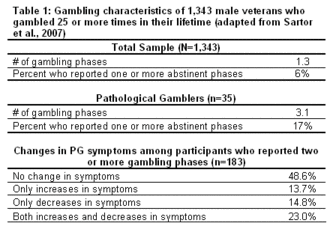The disease model of addiction assumes that addiction is chronic and progressive in nature. Current research suggests that addiction might not be as chronic or progressive as the model assumes. In this WAGER we examine a recent attempt by Sartor et al. (2007) to examine the course of pathological gambling over the lifetime using a gambling history measure modeled after the Lifetime Drinking History measure.
As part of a larger study of gambling behavior, researchers completed telephone interviews with 1,675 male twins from the Vietnam Era Twin Registry, 70% of those targeted. This study focuses on the 1,343 participants who recalled 25 or more lifetime gambling experiences. Interviewers administered the Lifetime Gambling History (LGH), modified from the Lifetime Drinking History developed by Skinner and Sheu (1982). The LGH identifies gambling phases (i.e., a respondent-defined period of time with consistent gambling behavior) over respondents’ lifetimes by querying respondents about significant changes in gambling activity and corresponding life events over time. For each phase, the LGH assesses the presence of gambling problem symptoms.
Participants reported an average of 1.3 gambling phases. Pathological gamblers (i.e., those who endorsed 5 or more symptoms for at least one phase) indicated an average of 3.1 phases and were also more likely (17.1% compared to 6.0% for the entire sample) to report phases of abstinence. Among participants who reported two or more phases (N=183) 48.6% reported no change in symptoms, 14.8% reported only decreases in symptoms, 13.7% reported only increases in symptoms, and 23.0% reported both positive and negative changes in symptoms over their lifetime (see Table 1).
Limitations of the current study include the retrospective self report, and the sample, which comprises only male twins between the ages of 45 to 60 who recalled gambling 25 times or more in their life. The results demonstrate that among those who reported more than one gambling phase, approximately half had symptoms that changed across time. The study did not report, though it is important to know, what proportion of those with stable symptom patterns and those with changing symptom patterns qualified as lifetime problem or pathological gamblers. If the group with no change in symptoms consisted primarily of gamblers without problems or at-risk gamblers, the interpretation is very different than if that group consisted primarily of problem or pathological gamblers. Future research might assess the validity of the LGH by comparing the results obtained from the LGH to those obtained prospectively.
What do you think? Comments can be addressed to John Kleschinsky.
References
Sartor, C. E., Scherrer, J. F., Shah, K. R., Xian, H., Volberg, R., & Eisen, S. A. (2007). Course of pathological gambling symptoms and reliability of the Lifetime Gambling History measure. Psychiatry Research, 152(1), 55-61.
Skinner, H. A., and Sheu, W.J.,. (1982). Reliability of alcohol use indices. The Lifetime Drinking History and the MAST. Journal of Studies on Alcohol, 43, 1157-1170.





